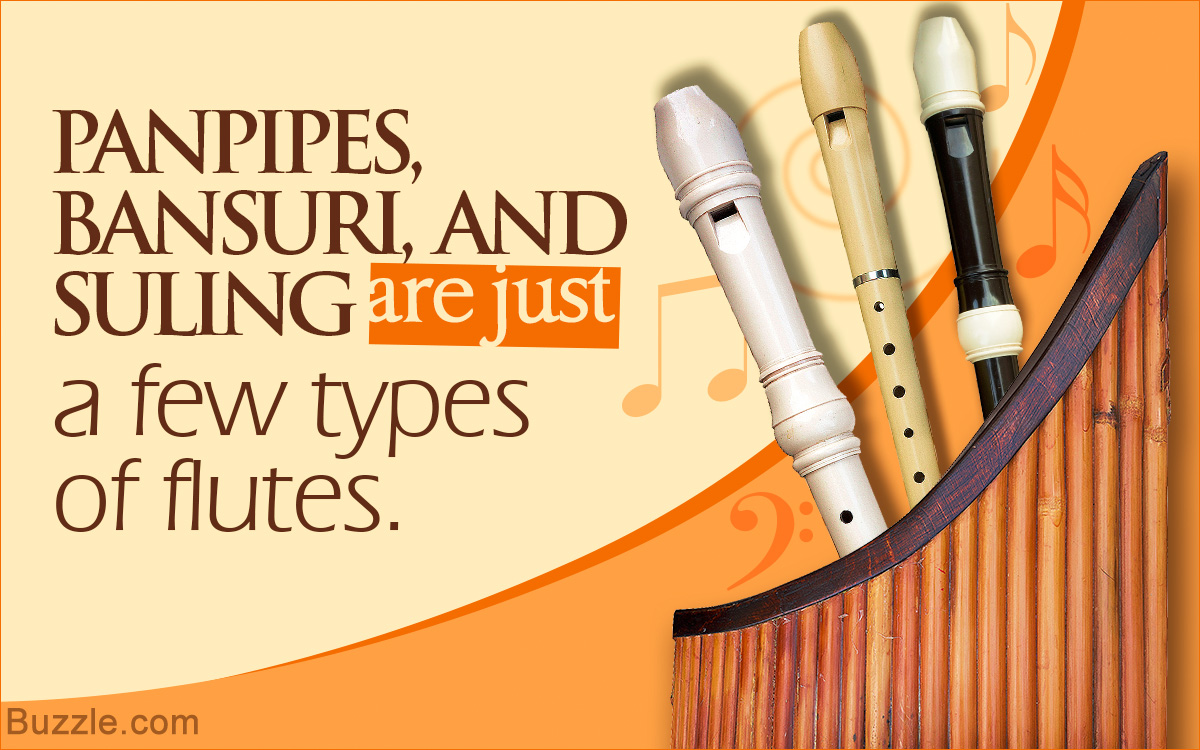
All members of the woodwind family have an uncanny knack for being brilliantly diverse in types, depending on so many things that it would take you ages to know all of them. Here are all the types of flutes created and used by man through time.
For those who think the flute is relatively modern (in terms of thousands of years), think again. The flute, in fact, has been documented as the oldest instrument of melody made by man. This comes from an archaeological discovery at the Ach Valley of Southern Germany, a flute made of bone that can be dated back by 35,000 years! After more excavation, it was concluded that the Ach Valley was quite the artistic hub back in the day. Of course, they probably had a different definition of what ‘Rock’ would sound like. Get it? Rock? No? Okay, Back to flutes, I have categorized them according to the way they are played, their shape and size and their period of creation. That makes for 9 types of flutes in all.
Flutes by Culture and Shape
Based on their home, the flutes are as variegated as they come. Click on any image to get an enlarged view of them.
The Panpipes
It consists of about 5 pipes in general, each pipe differing in size. The Panpipes(or pan flute) are completely flat at one end, with the other ends of each pipe trailing off. The different lengths of the pipes give out different notes, so instead of a single pipe with holes in it, you get multiple pipes with no holes.
The Panpipes are considered to be a folk instrument that originated from Greek culture. These type of flutes are linked to the Greek god Pan, hence the name Panpipes. Records of the instrument have been found through manuscripts and archaeological digs in places all around the worlds, from Central America to India.
The Ocarina
The instrument is too unique and simple, yet sounds amazing in its own light. The Ocarina is simple to make, easy to play and the fun can last for a lifetime. The English Pendant Ocarina can have just four holes for fingers and still get an entire octave! The instrument may have been globally available, but it was nowhere as famous or as widely used as it was in Japan. ‘The Legend of Zelda: The Ocarina of Time’, anyone? The game has to be the biggest reason for its comeback. The Ocarina’s charm is in its simplicity, the pitch gets changed simply by controlling the air flow inside the Ocarina where it keeps banging against the walls. The two basic types would be the pendant type and the chambered type. Small, simple and easy to use, the Ocarina is the definition of music that can be played anywhere.
The Recorder
The Recorder is one of the oldest flutes around that’s still in use. The Recorder is one the main reasons the Ocarina lost much of its hold over the musical domain. It grew to its greatest popularity during the Renaissance. The modern flute we use today like the Recorder’s younger brother- both were developed side by side historically. The soprano Recorder is the most common one used today. One can say that playing the Recorder remains as one of the easier things to do among the woodwind instruments.
The recorder gets its name from the early meaning of ‘record’, which means ‘to practice music’. The recorder is named ‘Flauto’ in Portuguese and Spanish. Over the passing of time however, it was discovered that the modern concert flute was richer in tones and better sounding than the recorder. That, coupled with the exponential rise in popularity of orchestras, led to the decline of the recorder.
The Suling

Well yes, ‘Suling’ in Balinese means ‘flute’. The Suling is the kind of flute that will change its size according to the celebration. It is made from bamboo and its size can be from 20cm to more than a meter, or from narrow to wide enough for additional support. Their size, like all concert flutes, is in reverse proportion to their base register- the larger ones play are meant for the bass notes and the smaller ones for the higher pitched notes. All Suling have six holes evenly spaced from each other.
The instrument was meant to be more of a humming flute and is known for its ease of producing a vibrato. This gives the suling its two popular effects. One is the slur, where you play notes in rapid succession within a single breath. The other effect is the ‘Puruluk’, which sort of resembles the flutter on an electric guitar. What you do is rapidly alternate between two notes in a scale in one breath.
The Japanese Shakuhachi
The Shakuhachi is an end-blown flute made out of bamboo. The Shakuhachi has no duct and therefore has a lower pitch control when compared to the Recorder. Although the ‘Bamboo flute’ came to Japan through China, they developed it on their own and named it the ‘Shakuhachi’, which means ‘one-eight(‘-hachi’) of 30.3 centimeters(‘Shaku-‘)’ in English. The traditional Japanese genre ‘honkyoku'(a form of soloist music) uses the Shakuhachi the most. The passage of time saw the transition of the Shakuhachi from traditional Japanese music to pop music and Hollywod soundtracks, including ‘The Last Samurai’ and ‘Memoirs of a Geisha’. The Shakuhachi can be dated back to times of the Komusō(traveling monks) in the Edo period. They would play the shakuhachi as they believed its sounds to be the path to enlightenment.
The characteristic sound of the shakuhachi is drawn by accepting what most other flutes try to avoid. It uses the empty notes that resemble the sound of wind or the tapping or beating that happens when you tap your fingers on the holes. The shakuhachi uses all these elements to portray not just one sound, but a whole scenery of music.
Bansuri
The Indian version of the bamboo flute, the Bansuri ranges from 12 inches to 40 inches, the 20 inch one being the most common. The regular Bansuri has six holes and both hands are used to control them. Depending on whichever holes you have left open or kept closed, the sound is produced due to resonance created inside the column of the instrument. The Bansuri is deceptively complicated, especially once you hear what a professional can do with it. Indian flutists consider playing the Bansuri as a way of life than a simple instrument.
The bansuri is perhaps the most popular flute played in India, apart from the Shehnai which is an oboe without keys. The main reason for its popularity is its link to the Hindu god Krishna, who often enthralled the women and animals when he played the flute. Lord Krishna is one of the most revered gods and therefore, the people’s love for him translates to their love for the flute.
Dizi
Another Asian flute made of bamboo would be the Dizi. It was created and is most popular in China. The instrument is also a six fingered flute, side-blown and has one membrane hole. While the Dizi is played horizontal, it has a vertical counterpart called the ‘Xiao’, which is the flute that the Shakuhachi originated from. Historical records show the Dizi is as old as 9,000 years old, although nothing much has changed about it. The Dizi still remains as the six-holed flute popular to the Chinese.
If you ever get to see a dizi flutist around you, he/she, in some way, will be inspired by the ‘Dragon Flute’ or Ron Korb, who made the dizi famous across the western part of the world by using it as the lead instrument in many of his compositions.
Fife
It is small, but do not underestimate its power! Ever wondered why the Fife is used during military drills and in marching bands? Because the fife has a high-pitched sound and sheer power to it that can get it heard over almost everything except a jet plane. In fact, early warfare records say that the Fife (coupled with drums) can be heard over 3 miles away, over all the artillery fire!
Orchestra fifes are in A flat, while the marching band fifes are in B flat, which means its lowest note playable is a B flat. What’s unique about the fife is its crudeness. The fife is built such that it fits in your pocket and makes a sound louder than any other instrument. Of course these requirements come with the drawback of the fife not being able to play more than a few pitches of chromatics and for the ones that you can play, you’ll find yourself to be grossly out of tune.
Irish Tin Whistle
Also known as the Scottish Penny whistle or just tin whistle, this instrument has everything to do with Celtic folk music. It is and end-blown fipple flute that is cheap(under $10 most of the time), easy to pick up and easy to master. Earlier records of the creation or the existence of the tin whistle are hard to pin-point. In fact, the German bone flute mentioned above can actually be said to be the earliest fipple flute that closely resembles the tin whistle. If you want to hear the tin whistle in Celtic-style action, listen to the Dropkick Murphys or The Tossers.
The Modern Flute
The concert flute or the modern flute is what you will be seeing more often if you live in America or Europe. It is the younger brother of the Recorder and is used almost everywhere. Here are the types of modern flutes.
Bass Flute in C
The largest of them all, the bass flute is in the key of C. The only modern flute larger than the bass flute is the contra-bass flute, which is two octaves below the concert flute.
Alto Flute in G
The alto flute uses the same fingering as required for the concert flute, while sharing a similar tubing with the bass flute. The alto was mainly designed for flute ensembles.
Tenor Flute in B♭
The tenor flute is tuned in the key of B♭. It is also known as ‘Flûte d’amour'(The Flute of Love), because of its rich tone that is believed to invoke the emotion of love.
Concert Flute in C
The most widely used flute amongst the modern flute family, the concert flute is not only famous for its contributions to Classical music, but also for its beauty seen in jazz or well, almost anywhere you need it.
Soprano Flute in E♭
Larger than the piccolo but 4 inches shorter than the concert flute, the soprano is the combination of both. Because of the slightly higher pitch, the flute is easier to blow into along with being easy to play.
Treble Flute in G
The treble flutes are higher than the concert flutes and are rarely seen in use. They are only seen in flute ensembles or some jazz performances.
Piccolo in C
It is the smallest of all the modern flutes, which is half the size of a concert flute and one whole octave higher.
This covers all the important flutes that you will come across as you walk across the musical world. You might come across some others like the subcontra-bass flute or the hyper-bass flute, which by now I hope you can figure out for yourselves. All that remains now is for you to take your pick, find inspiration and start playing.










